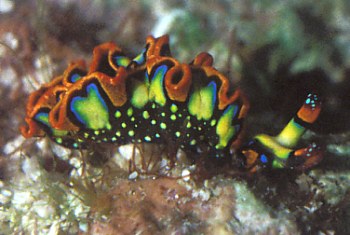
Thuridilla picta
(Verrill, 1901)
Order: SACOGLOSSA
Superfamily: ELYSIOIDEA
Family: Elysiidae
DISTRIBUTION
Carribean [Bermuda, Florida, Curacao]
East Atlantic Ids [Canary Ids, Cape Verde Ids, Madeira]
PHOTO
Littlehale's Lair medium reef, Lucaya, Grand Bahama Island, Bahamas, 18 November 1979, Depth: 50ft. Size: 12mm. Photos: Lindsay Warren.
The dorsal part of the head is yellow, sometimes with a white centre, and the sides are black with yellowish spots. The rhinophores are similarly coloured to the edge of the parapodia. The basal part of the rhinophores are yellow, then there is a bright blue band, with a zone of green where the blue and yellow merge. Above the blue band is a thin black band, and above that, the upper third of each rhinophore is orange-red, often with a white-spotted patch of black right at the tip. The parapodial edge is thrown into prominent folds. Then parapodia are black with a pattern of bright colours. At the edge of the parapodia is a broad orange-red border, which at intervals extends down into the black as an orange 'tongue'. Between the orange 'tongues' are large bright yellow quadrangular patches which have a bright blue band outlining the sides and top of each patch. As with the rhinophores, there is usually a green diffuse zone where the blue and yellow pigments merge. The rest of the black parapodia has scattered white or yellow spots of various sizes. The colour pattern is quite variable. The most noticeable variations are that the yellow can be a whitish cream, and the large yellow patches can merge into broad submarginal band.
References:
• Gosliner, T.E. (1995) The genus Thuridilla (Opisthobranchia: Elysiidea) from the tropical Indo-Pacific, with a revision of the phylogeny and systematics of the Elysiidae. Proceedings of the California Academy of Sciences, 49(1): 1-54.
• Marcus, Ev., (1980) Review of Western Atlantic Elysiidae (Opisthobranchia Ascoglossa) with a description of a new Elysia species. Bulletin of Marine Science, 30(1): 54-79.
• Ortea, J.A., Luque, A.A.. Templado, J. (1988) Elysia picta Verrill, 1901, and Geitodoris pusae (Marcus, 1955), two amphiatlantic opisthobranch gastropods. J. Moll. Stud., 54: 243-247.
• Verrill, A.E., (1901) Additions to the fauna of the Bermudas. Trans. Connecticut. Acad., 11 (1901-03) pt. 1(2): 15-62, pls 1-9.
• Wirtz, P. (1999) Opisthobranch molluscs from the Madeira Archipelago. Vita Marina, 46(1-2): 1-18.
Rudman, W.B., 2003 (July 23) Thuridilla picta (Verrill, 1901). [In] Sea Slug Forum. Australian Museum, Sydney. Available from http://www.seaslugforum.net/find/thurpict
Related messages
Thuridilla picta from Caribbean coast of Mexico
April 17, 2007
From: Todd Ashton
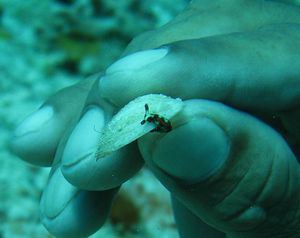
We saw the appended creature while diving at the Palancar Gardens reef in Cozumel Mexico. We were not able to identify the species. Please see the attached photo.
Locality: Palancar Reef, 65 feet, Mexico, Carribean Sea, March 11, 2007, Coral Reef. Length: 1 cm. Photographer: Todd Ashton.
Todd Ashton
tashton@shaw.ca
Ashton, T., 2007 (Apr 17) Thuridilla picta from Caribbean coast of Mexico. [Message in] Sea Slug Forum. Australian Museum, Sydney. Available from http://www.seaslugforum.net/find/19809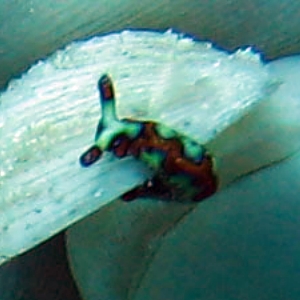
Dear Todd,
I like a challenge, but when I first saw your photo I thought this was a problem. However I have enlarged it a bit and luckily it is the very brightly coloured and unmistakable sacoglossan, Thuridilla picta. Have a look at the Fact Sheet for the species and accompanying messages for more information.
Best wishes,
Bill Rudman
Thuridilla picta from SE Florida, USA
March 7, 2007
From: Linda Ianniello
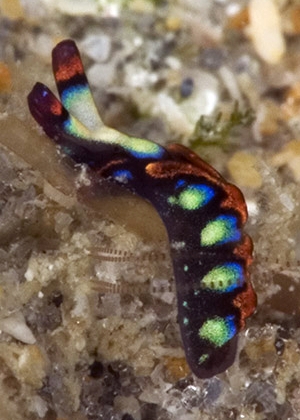
Dr. Bill,
We found our first Thuridilla picta in our area yesterday. It was tiny and in a very surgey area, so difficult to photograph. But I was pleased to get a few shots, one of which is attached.
Locality: Deerfield Beach, 9 feet, FL, USA, Atlantic Ocean, 03 March 2007, Ocean beach, sandy rubble. Length: less than half inch. Photographer: Linda Ianniello.
Regards,
Linda I.
lindai1@bellsouth.net
Ianniello, L.M., 2007 (Mar 7) Thuridilla picta from SE Florida, USA. [Message in] Sea Slug Forum. Australian Museum, Sydney. Available from http://www.seaslugforum.net/find/19597Dear Linda,
Congratulations on a new find. It is always good to find something new now and then. Your animal certainly seems to be a juvenile. In juveniles the head and rhinophores are usually much bigger in proportion to total body size, than they are in adults
Best wishes,
Bill Rudman
A Thuridilla? from the Canary Ids
July 26, 2005
From: Ana Isabel
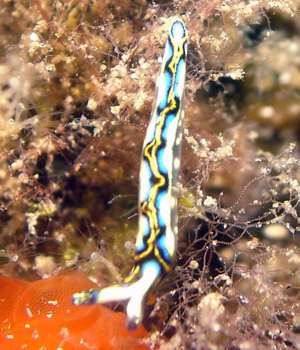
Hello
I am having problems identifying this one, photographied at Gran Canaria.
Locality: Gran Canaria Island, Canary Islands (Spain), Atlantic Ocean. Depth: < -20 m. Length: 1 cm. July 2005. Photographer: Mark Kaftan
Do you know which is?
Thank you :)
Ana
enciana@gmail.com
Isabel, I., 2005 (Jul 26) A Thuridilla? from the Canary Ids. [Message in] Sea Slug Forum. Australian Museum, Sydney. Available from http://www.seaslugforum.net/find/14295Dear Ana,
This is Thuridilla picta, which, as you can see from other messages, is very variable in colour pattern
Best wishes,
Bill Rudman
Re: Thuridilla picta from Cozumel, Mexico
January 9, 2004
From: Kathe R. Jensen
Dear Bill,
I have been looking at the alga in Paul Osmond's photo, but I am not sure I can give a correct dentification. Of course I would like to say that it is a Derbesia sp. since that would fit my hypothesis of evolution of diets in the Sacoglossa perfectly. I guess it could be, but I have not seen any reference to that genus from the Caribbean. It could also be Caulerpa fastigiata, which would also be okay for my hypothesis, though not perfect.
It is nice to see that a Thuridilla can actually be found on a suitable alga. All the animals I have collected have been on bare sediment or dead corals.
Happy New Year,
Kathe
krjensen@zmuc.ku.dk
Jensen, K.R., 2004 (Jan 9) Re: Thuridilla picta from Cozumel, Mexico. [Message in] Sea Slug Forum. Australian Museum, Sydney. Available from http://www.seaslugforum.net/find/11860Thanks Kathe,
Hopefully someone reading this will know an algologist who can help us with an identification
Best wishes
Bill Rudman
Re: Thuridilla picta from Cozumel, Mexico
January 8, 2004
From: Richard Goodman
Hello!
Funny, I saw exactly the same scene as Paul did -- I was in Cozumel just last week as well, and likewise saw the same species roaming through the same kind of green algae grass. I was thrilled to see them (on my last dive there no less -- at about 20-25 feet, at the Colombia Shallow site, to be specific), though from Paul's comments I can see that they may not be that hard to find after all -- once you know where to look!! They are truly spectacular, and Paul's images (among others) really do a great job of capturing their beauty. Oh, one small possible correction -- I believe Paul states "20m" in his comments, but perhaps that should actually be 20 feet?
Thanks for two truly fabulous websites (yours and Paul's both)!!
Rick
rmgoodman@yahoo.com
Goodman, R., 2004 (Jan 8) Re: Thuridilla picta from Cozumel, Mexico. [Message in] Sea Slug Forum. Australian Museum, Sydney. Available from http://www.seaslugforum.net/find/11848Thanks Rick,
I checked with Paul and he confirms the depth was 20 metres. I guess they are likely to be found whereever the algae they feed on lives. And one limiting factor for the algae will be the depth to which sufficient light can penetrate for photosynthesis to occur.
Cheers
Bill Rudman
Thuridilla picta from Cozumel, Mexico
January 6, 2004
From: Paul Osmond
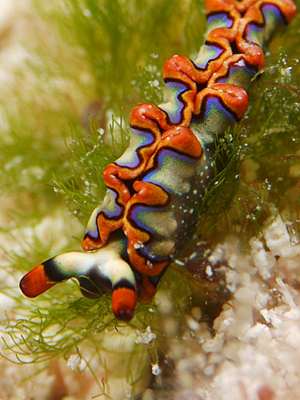
Dear Bill,
Here are some images of Thuridilla picta on its food source during a week of diving in Cozumel, Mexico [Sat 13 December, 2003].
We saw probably as many as 150 during the week - it was simply a matter of finding their food source (the algae/sea grass seen in this image) and then looking carefully to see if any specimans were on it.
They tended to be in about 20m of water, and on the top of the Cozumel reef walls. I didn't see any specimans much deeper than 20m nor any on the actual reef walls in Cozumel despite the abundance of their food source at depth.
Additional images taken of this species during this trip can be seen in my online gallery
Thanks,
Paul Osmond
marriard@deepseaimages.com
![]()
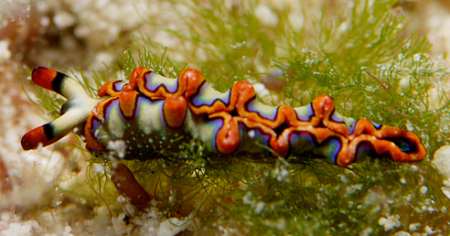
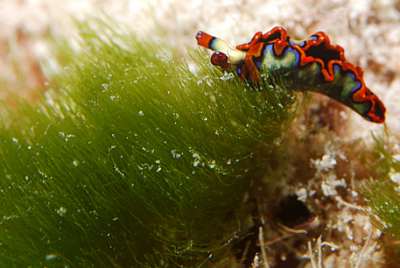
Thanks Paul,
I can't offhand find a reference to the algae this species eats, so your observation may be a new bit of information. Hopefully someone can help us identify it to species.
Best wishes
Bill Rudman
Thuridilla picta from Canary Ids
July 29, 2003
From: Bianca Rijnders
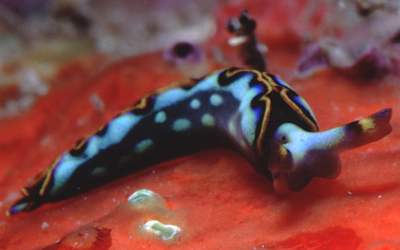
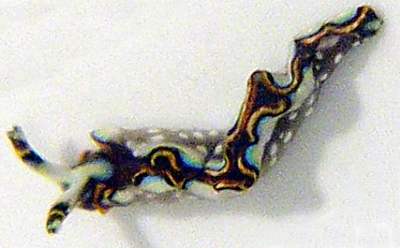
Hello,
First of all compliments for your fantastic Forum, I will certainly return to it on a regular basis! I was given your "link" by a biologist of the University of La Laguna in Tenerife, Canary Islands, who helped me identify this animal, which fascinated me, so small, yet so spectacular.
I found a specimen of Thuridilla which is thought to be a Thuridilla picta during a dive in the south of the island (I'm a scuba instructor here). I attach two pictures, one that was taken by me in the south of the island, and one which was send by the marine biologist, which was taken in the north. However, in your page I see that this species is considered to live only in the Carribean. Does this mean this is a different species?
Bianca Rijnders
info@mirazul.com
Rijnders, B., 2003 (Jul 29) Thuridilla picta from Canary Ids. [Message in] Sea Slug Forum. Australian Museum, Sydney. Available from http://www.seaslugforum.net/find/10545Dear Bianca,
Your animal has certainly been identified with Thuridilla picta, from the Caribbean, and also has similarities to the Mediterranean Thuridilla hopei. Thanks for drawing my attention to the absence of the eastern Atlantic islands from the distribution data. I look forward to photos of any other interesting finds you make. Photos of any species from the Canary Ids would be valuable as our knowledge of the relationship between the east and west Atlantic faunas is still poor.
• Wirtz, P. (1999) Opisthobranch molluscs from the Madeira Archipelago. Vita Marina, 46((1-2)): 1-18.
• Ortea, J.A., Luque, A.A.. Templado, J. (1988) Elysia picta Verrill, 1901, and Geitodoris pusae (Marcus, 1955), two amphiatlantic opisthobranch gastropods. J. Moll. Stud., 54: 243-247.
Best wishes,
Bill
Painted Elysia from Mexico
August 12, 2002
From: Maxi
Hi!
My name is Maxi and I live and work in scuba diving in Cozumel, Mexico ... Maybe this is not the place, but i would like to find information about the 'Painted Elysia'. If you can help me with this i would really appreciate it!
Thank you very much
Maxi Rodriguez Consoli
DM# 164329
bartmaxi@hotmail.com
Consoli. M.R., 2002 (Aug 12) Painted Elysia from Mexico. [Message in] Sea Slug Forum. Australian Museum, Sydney. Available from http://www.seaslugforum.net/find/7755Dear Maxi,
This indeed the place to ask such questions. Common names like 'Painted Elysia' I not very useful because they mean different things in different parts of the world. I see that Cozumel Island is off the Yucatan Peninsula, so the animal you are interested in is a Caribbean species. One species from there that is sometimes called the 'Painted Elysia', because of its bright colours is Thuridilla picta. If you look at the Fact Sheet you will see some photos of it.
I am not sure what sort of information you are interested in. It belongs to a group of sea slugs, the sacoglossans, which are herbivorous, sucking the cell contents from the algae they feed on. Most species have a preference for one, or sometimes a few, particular species of algae. Some sacoglossans keep a special part of the algal cell - the chloroplasts - alive in their own bodies. The chloroplasts have a very special job in the algae - they convert the sun's energy into sugars for the plant's nutrition in a process we call photosynthesis. The sacoglossans are able to keep the chloroplasts functioning in their own bodies. Have a look at the solar-powered sea slug page for some more information on this topic. I am not sure if Elysia picta does this.
If you have photos of any sea slugs from your part of the world they would be of great interest.
Best wishes,
Bill Rudman
Thuridilla picta from the Bahamas
June 7, 2002
From: Lindsay Warren


Dear Bill
I was just looking through some photos I took quite a long time ago and came across these two shots of what I believe to be Elysia picta - a stunning little number! I found the possible id in Paul Humann's 1992 - Reef Creature Identification. Unfortunately there is no indication as to species author so I have not been able to check any other literature. I thought you might like these for the Forum. Perhaps you could let me know where the original description appeared.
I found it at Littlehale's Lair medium reef, Lucaya, Grand Bahama Island, Bahamas on 18 November 1979 at a depth of 50ft. Size: 12mm. Photos: Lindsay Warren
All the best
Lindsay
alldcl@compuserve.com
Warren, L., 2002 (Jun 7) Thuridilla picta from the Bahamas. [Message in] Sea Slug Forum. Australian Museum, Sydney. Available from http://www.seaslugforum.net/find/7148Thanks Lindsay,
Until quite recently this has been considered a species of Elysia, but in Gosliner's review of the Indo-West Pacific species of Thuridilla he examined its anatomy and found that it should be placed in that genus. I have put some relevant references on the Fact Sheet.
Best wishes,
Bill Rudman
